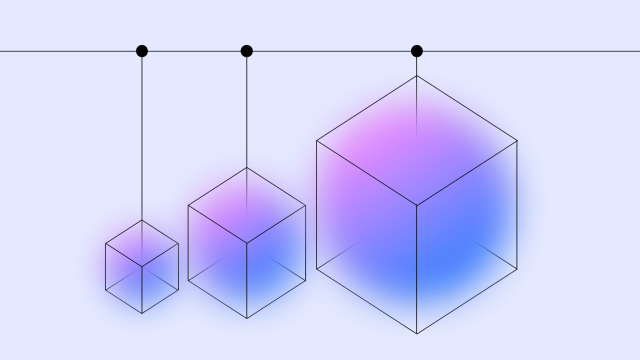Enterprise transformation
– 7 min read
The Agentic Compact: The trust blueprint for the human-agent enterprise

Just a year ago, launching a new product tied to a holiday campaign was a seven-month marathon of meetings, emails, and crossed wires. By the time you went live, the trend had already peaked. Today, a single sentence can kick off that entire process, from product descriptions and packaging copy to localized ad creative and compliance checks. A system of AI agents can now accomplish in minutes what used to take a team of people months.
This isn’t a distant future. It’s our new reality. Agents are no longer just tools on the periphery. They are becoming our teammates, weaving themselves into the very fabric of our businesses by planning, deciding, and acting. The nature of collaboration itself is being rewritten before our eyes, shifting from human-to-human to human-and-agent, side-by-side.
It’s uncharted territory, and I’ll be the first to admit it can sometimes feel unnerving. This new class of entity — somewhere between a tool and a teammate — is surfacing incredible opportunities, but also unprecedented challenges. And as leaders, we are on the front lines.
We have the opportunity to reimagine our firms for a world of limitless execution. Where instead of monolithic, one-size-fits-all software, we have personalized agentic solutions that adapt to our business, know our data, speak our language, and act with precision. It’s a future where the distance between idea and result is nearly instantaneous.
But the fundamental challenge is that we cannot build that future without trust. While a handful of agents can be managed with a watchful eye, deploying fleets of hundreds or thousands demands a systemic framework to ensure consistency and accountability across every model, data source, and workflow.
The CIO’s governance dilemma
In a hybrid workforce of humans and autonomous agents, how do you foster collaboration when your new teammates don’t have instincts, but operate on logic you can’t always see?
Over the past year, I’ve talked with hundreds of leaders who are all wrestling with the same paradox. We’re all incredibly excited about the power of agents to transform our businesses, but there’s a deep-seated anxiety that comes with handing over the keys. How do we integrate this technology in a way that’s responsible and safe? And in a way that our people can get behind, understand, and trust?
The existing playbooks present a Goldilocks dilemma. CIOs are diligently seeking the right path, but their options are fundamentally mismatched for the agentic era.
On one hand, today’s responsible AI frameworks provide a valuable theoretical starting point. But they were designed to govern probabilistic models that generate outputs, not autonomous agents that take action. And while the conversations in academic labs are fascinating, they don’t address the immediate, pragmatic questions we face in the enterprise. We aren’t building science projects; we’re deploying powerful systems into the heart of our operations, and we are accountable for what they do.
On the other hand, leaders are defaulting to their existing enterprise software playbooks. But these frameworks are too rigid, built for deterministic systems that follow predictable rules. Applying a SaaS compliance checklist to an autonomous agent is a category error in risk management.
Neither is just right. This is the governance gap we must now close.
Agentic governance is an operating system, not just a feature
In the agentic era, robust technological controls and compliance are the absolute price of entry. But they are not the destination.
You cannot simply ‘comply’ your way into a collaborative relationship with an autonomous agent, because true governance is not just a technical problem — it’s an organizational one. It requires a new operating system for the business itself, one built on a foundation of verifiable trust that spans technology, systems, and people. This new operating system doesn’t require a ‘rip and replace’ approach. It’s about creating an intelligent layer of action that integrates with the systems you already have, making them more powerful.
Without this holistic approach, even the best technological controls are a house built on sand.
The questions every leader must now ask
In our work with enterprise leaders on the front lines of this shift, a new set of questions is emerging — conversations that are happening in boardrooms and strategy sessions around the world. They are no longer abstract thought experiments; they are the urgent, pragmatic questions every leader must now ask.
- How do we measure value when we co-author outcomes with AI?
- How do we create a system of record for autonomous actions, ensuring every decision is observable, explainable, and auditable?
- Who is accountable when an autonomous agent makes a mistake?
- How do we design a resilient system of agents that can adapt without requiring constant human intervention?
- What new ladders of opportunity will we build — and who gets to climb them?
The Agentic Compact: A framework for a new reality
These conversations have informed a new social contract — a framework we call the Agentic Compact. It’s the product of a deep, collaborative effort across the entire WRITER community, and it represents a new answer for a new era. It is a framework for building the essential foundation of trust that makes human-agent collaboration possible, profitable, and safe.
The Compact is built on six essential commitments that build the trust necessary to scale, across technology, systems, and people. These six commitments are what separate a fragile AI experiment from a resilient, scalable agentic enterprise. They are your blueprint for going from a few agents in production to a company that runs on them.
Systemic Safety & Containment: Can you tell your board, with certainty, how you would contain a rogue agent? This is about having the confidence to deploy agents at scale without risking operational integrity.
Foundational Transparency: Do you have genuine insight into why your agents are operating the way they are, or just what they are doing? It’s one thing to see what an agent is doing. It’s another thing entirely to understand its reasoning.
Actionable Explainability: Can you trace an agent’s action back to a specific business goal, creating a clear chain of accountability? When an agent takes an action, you need to be able to trace its path backward, not just to the model that powered it, but to the specific business goal that prompted it.
Continuous Observability: Are you monitoring agent performance in real-time, and can you tie it directly to business impact? We need to be able to see not just what our agents are doing, but what impact they’re having on the business.
Workforce Enablement & Education: Are you investing in your team’s future, or are you just focused on cutting costs? Your people are not a cost to be cut. They are your most valuable asset, and in the age of AI, their role becomes even more critical.
The Human Mandate: Can you prove that every action your agents take is aligned with both your company’s values and its business goals? This is the ultimate backstop, ensuring every action an agent takes is in service to your people and your business.
These aren’t just technical requirements; they are challenges to us as leaders to grapple with the deeply human questions that will define the next era of work. Your answers to these questions will look different for every company, and they will evolve. The goal isn’t to have perfect answers today. The goal is to start asking the right questions.
The mandate for a new generation of leaders
The transition to an agentic enterprise is the defining leadership challenge of our generation. The choice is no longer if we will integrate agents into our work, but how we will build the future alongside them.
The Agentic Compact is our contribution to this pivotal moment. If enterprises get this right, AI agents won’t just replace tasks. They’ll create space for more opportunity, more creativity, and more deeply human work that only we can do.
The principles outlined here are just the beginning. To fully explore the framework for building a thriving, human-centric, and AI-powered enterprise, download the full whitepaper: ‘The Agentic Compact.’
The blueprint is here. It’s time to start building.



